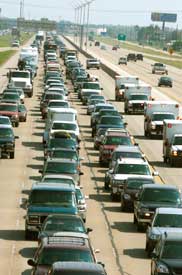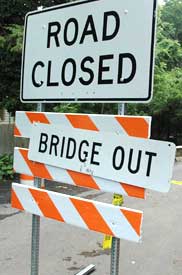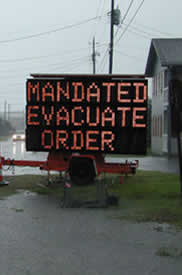Printable Version [PDF, 1.31 MB]
To view PDF files, you need the Adobe Acrobat Reader.
Contact Information: Operations Feedback at OperationsFeedback@dot.gov.
Technical Memorandum For Federal Highway Administration on Case Studies
Assessment of State of the Practice and State of the Art in Evacuation Transportation Management |
   |

February 6, 2006
Produced in collaboration with the
Intelligent Transportation Systems Joint Program Office (ITS JPO)
Images courtesy of the Federal Emergency Management Agency (FEMA)
Credits: Ed Edahl (left), Leif Skoogfors (center), Dave Gatley (right) |
Technical Report Documentation Page
Table of Contents
1 EXECUTIVE SUMMARY
1.1 Organization of the Case Studies
1.2 Summary of the Events
1.3 Summary of the Findings
1.3.1 Common Successes
1.3.2 Transportation Impacts
1.3.3 Transit Agency Participation
1.3.4 Difficulties in the Evacuation
1.3.5 Special Needs Evacuations
1.3.6 Lessons Learned
1.3.7 Best Practices
1.4 Recommendations
1.4.1 Devices
1.4.2 Services
2 INTRODUCTION
3 CASE STUDY #1 – El Dorado, Arkansas – Hazardous-Material Fire, January 2, 2005
3.1 What Happened
3.1.1 Incident
3.1.2 Evacuation
3.2 Community
3.3 Focus
3.4 Transportation Impacts
3.5 Advance Planning and Preparation
3.5.1 Drills, Tabletop Exercises, and Incidents
3.5.2 Equipment/Supplies
3.5.3 Emergency Preparedness Plan
3.5.4 Manpower
3.5.5 Monthly Emergency Planning Meetings
3.5.6 Public Shelters
3.6 Communication
3.6.1 Communication Between Agencies
3.6.2 Communication to Evacuees and the Public
3.7 Use of ITS Equipment/Advanced Technology
3.8 Coordination
3.9 Decision Making
3.10 Difficulties in the Evacuation
3.10.1 Determination of the Chemical Involved
3.10.2 Legal Actions
3.10.3 Receipt of Information from Other Entities
3.11 After-Action Report
3.12 Special Needs Evacuations
3.12.1 Evacuation of the El Dorado County Jail Facility
3.12.2 Evacuation of Nursing Homes
3.13 Best Practices
3.14 Lessons Learned
3.15 What Worked and What Did Not Work
3.15.1 What Worked
3.15.2 What Did Not Work
3.16 Improvements for Next Time
4 CASE STUDY #2 – Graniteville, South Carolina – Train Derailment and Chlorine Leak, January 6, 2005
4.1 What Happened
4.1.1 Incident
4.1.2 Evacuation
4.2 Community
4.3 Focus
4.4 Transportation Impacts
4.4.1 Evacuation Zone
4.4.2 Receipt of Train Manifest
4.5 Advance Planning and Preparation
4.5.1 Drills and Incidents
4.5.2 Emergency Preparedness Plan
4.5.3 Preplans
4.5.4 Public Shelters
4.6 Communication
4.6.1 Communication between Agencies
4.6.2 Communication to Evacuees and the Public
4.6.3 Communication – Miscellaneous
4.7 Use of ITS Equipment/Advanced Technology
4.8 Coordination
4.8.1 Initial Coordination
4.8.2 Additional Resources
4.9 Decision Making
4.10 Difficulties in the Incident/Evacuation
4.11 After-Action Reports
4.12 Special Needs – Pets
4.13 Best Practices
4.14 Lessons Learned
4.15 What Worked and What Did Not Work
4.15.1 What Worked
4.15.2 What Did Not Work
4.16 Improvements for Next Time
5 CASE STUDY #3 – South Salt Lake City, Utah – Toxic Chemical Spill, March 6, 2005
5.1 What Happened
5.1.1 Incident
5.1.2 Evacuation
5.2 Community
5.3 Focus
5.4 Transportation Impacts
5.5 Advance Planning
5.5.1 Drills – Practice
5.5.2 Evacuation Plan for Incident
5.5.3 Public Shelters
5.6 Communication
5.6.1 Communication between Agencies
5.6.2 Communication to Evacuees and the Public
5.7 Use of ITS Equipment/Advanced Technology
5.8 Coordination
5.9 Decision Making
5.10 Difficulties in the Incident/Evacuation
5.11 After-Action Reports
5.12 Best Practices
5.13 Lessons Learned
5.14 What Worked and What Did Not Work
5.14.1 What Worked
5.14.2 What Did Not Work
5.15 Improvements for Next Time
6 CASE STUDY #4 – Big Bear Valley, California – Old Fire, October 25, 2003
6.1 What Happened
6.1.1 Incident
6.1.2 Evacuation
6.2 Community
6.3 Focus
6.4 Transportation Impacts
6.5 Advance Planning
6.5.1 Evacuation Plans
6.5.2 Public Shelters
6.5.3 Tabletop Exercises – Training
6.5.4 Updates to Other Entities
6.6 Communication
6.6.1 Communication between Agencies
6.6.2 Communication to Evacuees and the Public
6.7 Use of ITS Equipment/Advanced Technology
6.8 Coordination
6.8.1 Unified Incident Command
6.8.2 San Bernardino County Mountain Area Safety Taskforce (MAST)
6.8.3 Transit Agencies
6.9 Decision Making
6.10 Difficulties in the Incident/Evacuation
6.11 After-Action Reports
6.12 Special Needs
6.12.1 Bear Valley Community Hospital
6.12.2 Big Bear Valley Schools
6.13 Best Practices
6.14 Lessons Learned
6.15 What Worked and What Did Not Work
6.15.1 What Worked
6.15.2 What Did Not Work
6.16 Improvements for Next Time
7 Summary of the Findings
7.1 Observations
7.2 Common Successes
7.2.1 Incident Command
7.2.2 Training
7.3 Focus
7.3.1 Beginning of the Evacuation
7.3.2 During the Evacuation
7.3.3 After the Evacuation
7.4 Transportation Impacts
7.4.1 El Dorado, Arkansas
7.4.2 Graniteville, South Carolina
7.4.3 South Salt Lake City, Utah
7.4.4 Big Bear Valley, California
7.5 Advance Planning and Preparation
7.5.1 Drills – Tabletop Exercises
7.5.2 Emergency Preparedness Plan
7.5.3 Evacuation Plan for the Incident
7.5.4 Local Emergency Planning Committee
7.5.5 Public Shelters
7.5.6 Updates to Other Entities
7.6 Communication between Entities and to Evacuees and the General Public
7.6.1 Entities
7.6.2 Evacuees and the General Public
7.7 Use of ITS Equipment/Advanced Technology
7.7.1 South Salt Lake City, Utah
7.7.2 Big Bear Valley, California
7.8 Coordination Efforts
7.9 Decision Making
7.10 Difficulties in the Incident/Evacuation
7.11 After-Action Reports
7.12 Special Need Evacuations
7.12.1 Focus
7.12.2 El Dorado, Arkansas – El Dorado County Jail Facility
7.12.3 El Dorado, Arkansas – Hillsboro Manor Nursing Home
7.12.4 El Dorado, Arkansas – Oakridge Nursing Home
7.12.5 Graniteville, South Carolina
7.12.6 Big Bear Valley, California – Bear Valley Community Hospital
7.12.7 Big Bear Valley, California – Bear Valley Schools
7.13 Best Practices
7.14 Lessons Learned
7.14.1 Advance Planning
7.14.2 Advanced Technology
7.14.3 Coordination
7.14.4 Communication
7.14.5 Transportation
7.15 What Worked and What Did Not Work
7.15.1 What Worked
7.15.2 What Did Not Work
7.16 Improvements for Next Time
7.16.1 El Dorado, Arkansas
7.16.2 Graniteville, South Carolina
7.16.3 South Salt Lake City, Utah
7.16.4 Big Bear Valley, California
8 Recommendations for Improved Evacuation Transportation Planning and Management Methods
8.1 Devices
8.1.1 Handheld Communication Devices
8.1.2 Portable Message Signs
8.2 Services
8.2.1 2-1-1 System
9 Appendix
9.1 Appendix 1 – Organizations Contacted
9.2 Appendix 2 – EPA After-Action Report
9.3 Appendix 3 – Entities Involved in Graniteville, South Carolina Incident
9.4 Appendix 4 – Aiken County Sheriff's Office Fact Sheet
9.5 Appendix 5 – Things To Do Upon Your Return Home
9.6 Appendix 6 – Aiken County Emergency Services After-Action Report
9.7 Appendix 7 – Aiken County Sheriff's Office After-Action Report
9.8 Appendix 8 – GVW Fire Department After-Action Report
NOTICE
This document is disseminated under the sponsorship
of the Department of Transportation in the interest
of information exchange. The United States Government
assumes no liability for its contents or use thereof.
This report does not constitute a standard, specification,
or regulation.
The United States Government does not endorse
products or manufacturers. Trade and manufacturers’
names appear in this report only because they are
considered essential to the object of the document.
Contact Information
For additional information on this report, contact Operations Feedback at OperationsFeedback@dot.gov.

U.S. Department of Transportation
Federal Highway Administration
Office of Operations
1200 New Jersey Avenue, SE
Washington, DC 20590
www.ops.fhwa.dot.gov
February 6, 2006
Publication #FHWA-HOP-08-014



![]()
